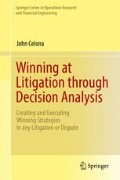Abstract
In this chapter, we cover how to test your analysis for possible shortcomings and how to overcome them, including attitude towards risk (risk preference). In addition, we show how you can calculate explicit values of information to guide further data gathering efforts (such as further discovery) and the value of influencing or controlling the outcome of the various uncertainties (such as through a stipulation, motion for summary judgment, etc.). The result should be a solid strategy that you can explain, justify, and act on to acheive the best possible result.
Access this chapter
Tax calculation will be finalised at checkout
Purchases are for personal use only
Notes
- 1.
You will still be maximizing your certain equivalent—if you do the math to make sure you’re considering your risk attitude consistently. However, you will giving up the risk penalty ; in effect, paying a premium for your risk aversion just like the way you pay a premium to insurance companies over your possible losses.
- 2.
A utility scale, like a temperature scale, can be calibrated to any two desired points. For example, Celsius is calibrated to water freezing at 0 °C and boiling at 100 °C. Fahrenheit is calibrated to water freezing at 32 °F and boiling at 212 °F.
- 3.
The author wishes to note that he is utterly opposed to gender stereotyping, sexism, or discrimination of any sort. Regrettably, this problem was inspired by actual experiences and is included to illustrate that even issues one would wish don’t exist can be analyzed. In particular, this sort of analysis would be very helpful in discrimination litigation.
Author information
Authors and Affiliations
Rights and permissions
Copyright information
© 2016 Springer International Publishing Switzerland
About this chapter
Cite this chapter
Celona, J. (2016). Analyze the Results. In: Winning at Litigation through Decision Analysis. Springer Series in Operations Research and Financial Engineering. Springer, Cham. https://doi.org/10.1007/978-3-319-30040-5_7
Download citation
DOI: https://doi.org/10.1007/978-3-319-30040-5_7
Published:
Publisher Name: Springer, Cham
Print ISBN: 978-3-319-30038-2
Online ISBN: 978-3-319-30040-5
eBook Packages: Mathematics and StatisticsMathematics and Statistics (R0)

